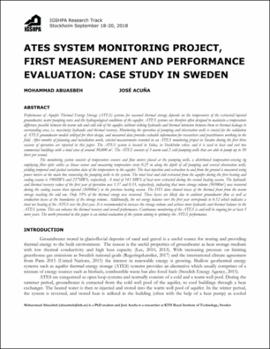| dc.contributor.author | Abuasbeh, Mohammad | |
| dc.contributor.author | Acuna, Jose | |
| dc.contributor.other | IGSHPA Research Track (2018) | |
| dc.date.accessioned | 2018-08-28T17:58:46Z | |
| dc.date.available | 2018-08-28T17:58:46Z | |
| dc.date.issued | 2018 | |
| dc.identifier | oksd_ighspa_2018_abuasbeh | |
| dc.identifier.uri | https://hdl.handle.net/11244/301547 | |
| dc.description.abstract | Performance of Aquifer Thermal Energy Storage (ATES) systems for seasonal thermal storage depends on the temperature of the extracted/injected groundwater, water pumping rates and the hydrogeological conditions of the aquifer. ATES systems are therefore often designed to maintain a temperature difference possible between the warm side and cold side of the aquifer, without risking hydraulic and thermal intrusion between them or thermal leakage to surrounding area, i.e. maximize hydraulic and thermal recovery. Monitoring the operation of pumping and observation wells is crucial for the validation of ATES groundwater models utilized for their design, and measured data provides valuable information for researchers and practitioners working in the field. After months of planning and installation work, selected measurements recorded in an ATES monitoring project in Sweden during the first three seasons of operation are reported in this paper. The ATES system is located in Solna, in Stockholm esker, and it is used to heat and cool two commercial buildings with a total area of around 30,000 m2. The ATES consists of 3 warm and 2 cold pumping wells that are able to pump up to 50 liters per second. | |
| dc.description.abstract | The monitoring system consists of temperature sensors and flow meters placed at the pumping wells, a distributed temperature-sensing rig employing fiber optic cables as linear sensor and measuring temperature every 0.25 m along the depth of all pumping and several observation wells, yielding temporal and spatial variation data of the temperature in the aquifer. The heat injection and extraction to and from the ground is measured using power meters at the main line connecting the pumping wells to the system. The total heat and cold extracted from the aquifer during the first heating and cooling season is 190MWh and 237MWh, respectively. A total of 143 MWh of heat were extracted during the second heating season. The hydraulic and thermal recovery values of the first year of operation was 1.37 and 0.33, respectively, indicating that more storage volume (50500m3) was recovered during the cooling season than injected (36900m3) in the previous heating season. The DTS data showed traces of the thermal front from the warm storage reaching the cold one. Only 33% of the thermal energy was recovered. These losses are likely due to ambient groundwater flow as well as conduction losses at the boundaries of the storage volume. Additionally, the net energy balance over the first year corresponds to 0.12 which indicates a total net heating of the ATES over the first year. It is recommended to increase the storage volume and achieve more hydraulic and thermal balance in the ATES system. This can enhance the thermal recovery and overall performance. Continuous monitoring of the ATES is and will be ongoing for at least 3 more years. The work presented in this paper is an initial evaluation of the system aiming to optimize the ATES performance. | |
| dc.format | application/pdf | |
| dc.language | en_US | |
| dc.publisher | International Ground Source Heat Pump Association | |
| dc.rights | In the Oklahoma State University Library's institutional repository this paper is made available through the open access principles and the terms of agreement/consent between the author(s) and the publisher. The permission policy on the use, reproduction or distribution of the article falls under fair use for educational, scholarship, and research purposes. Contact Digital Resources and Discovery Services at lib-dls@okstate.edu or 405-744-9161 for further information. | |
| dc.title | Ates system monitoring project, first measurement and performance evaluation: Case study in Sweden | |
| osu.filename | oksd_ighspa_2018_abuasbeh.pdf | |
| dc.identifier.doi | 10.22488/okstate.18.000002 | |
| dc.type.genre | Conference proceedings | |
| dc.type.material | Text | |
